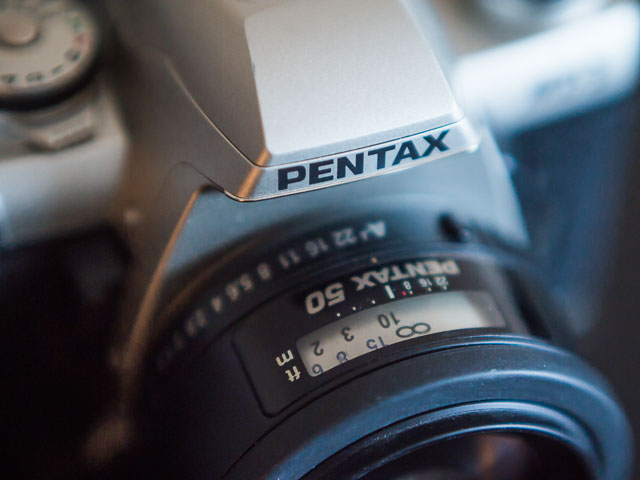Pentax MZ-3
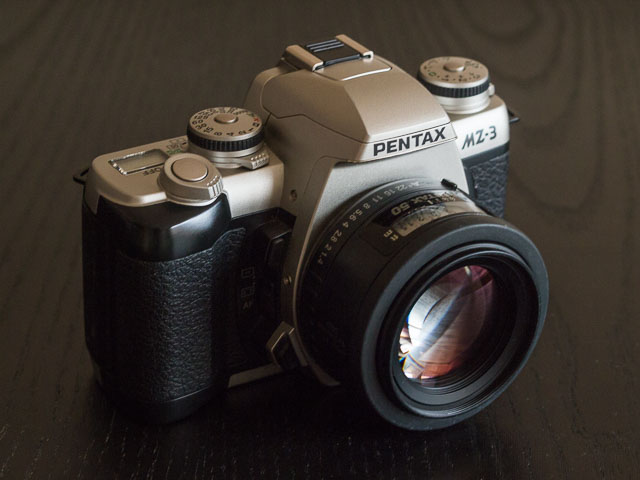
In the 1970’s Pentax established quite a reputation for building some of the smallest and lightest 35mm SLR equipment around with their M series cameras and lenses. But as the years went by Pentax cameras seemed to get bigger and bigger, particularly with the SF and Z series auto focus cameras. But in mid 1990s Pentax decided to return to their compact roots with the MZ series AF SLRs. The first cameras of the MZ series were the MZ-5 and MZ-10 of 1996. These two camera established two levels for the MZ series. The single digit cameras provided enthusiasts with plenty of features and old fashioned dials, while the double digit camera were entry level models aimed at those upgrading from compact point-and-shot cameras. But both series were extremely small and light: the MZ-5 weighed in at 400 grams and the MZ-10 was a mere 365 grams.
(Later on in the MZ series Pentax rather spoilt the neat simple dichotomy with the MZ-6 and MZ-7 models which sat some what between the existing single and double digital models, both in terms of user interface and feature set.)
It was actually quite a surprise to see Pentax return to old fashioned dials since they were the very first camera maker to experiment with alternative methods for controlling shutter speeds. In 1980 their ME Super model was the very first camera to provide manual control over shutter speeds using push buttons.
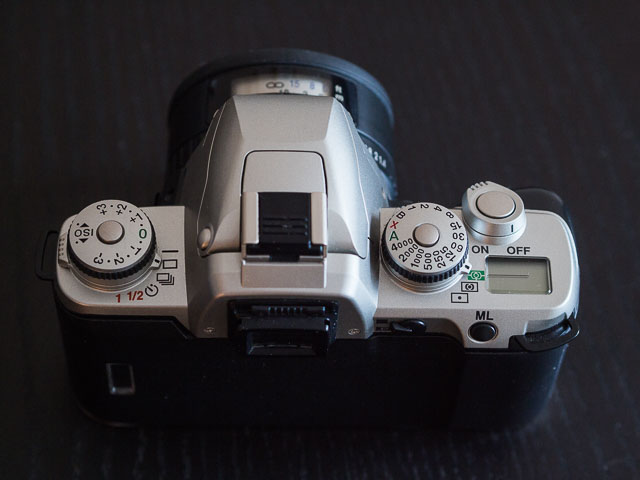
In 1997 the MZ-5 was replaced with the mildly updated MZ-5n (the ‘n’ model added depth-of-field preview, AE lock and a rather silly and pointless panorama function), and it was also joined by a new model, the MZ-3 which you can see here. The only advantage of the MZ-3 over the MZ-5n was a top shutter speed of 1/4000th second (instead of 1/2000th). I think the real point of the MZ-3 was really just to provide a more prestigious partner for the first of Pentax’s FA Limited lenses, the 43mm f/1.9, which was sold as a rather expensive kit with the MZ-3.
To the right you can see the top plate of the MZ-3 with it’s old fashioned dials.. These dials provide an extremely simple way to control exposure parameters and modes. To set aperture priority mode you just set the shutter speed dial to ‘A’ and use the aperture ring on the lens to control the aperture.
To set shutter speed priority mode you just set the aperture ring on the lens to ‘A’ and then control shutter speed using the shutter speed dial. And to set fully automatic mode you just have to set both controls to ‘A’, or take both control off ‘A’ to set fully manual mode.
This is both extremely intuitive and it also allows you to see the current setting at a glance even when the camera is turned off. But there are disadvantages too: you don’t get any kind of program shift function. It also means that to gain access to aperture priority and fully manual mode you must have a lens with an aperture dial, which some of Pentax’s most recent lenses lack.
Another slight disadvantage of the MZ-5 and MZ-3 models is that the very small LCD panel provides no room to display the exposure variables currently being automatically controlled by the camera. You have to look in the viewfinder to get this information.
But despite these disadvantages the extremely compact dimensions, together with light weight and simple, intuitive, operation makes the MZ-5 and MZ3 models highly desirable.
One of the big problems with the entire Pentax MZ series of cameras (with the exception of the MZ-S) is very poor reliability. If my experience is anything to go by, you will see many more broken MZ cameras than working examples! And to emphasise the point, my beautiful MZ-3 recently succumbed to the dreaded mirror lock-up problem :-( I have now replace my MZ-3 with a beatiful MZ-S… fingers crossed the MZ-S really is more reliable than the rest of the MZ series! (An MZ-S profile is coming shortly.)
My Pentax MZ-3 system
Pentax FG battery pack
All the MZ series cameras use CR2 batteries which can be a difficult to get hold of. This battery pack allows you to use AA batteries instead. As a by-product the increased height improves the handling somewhat.
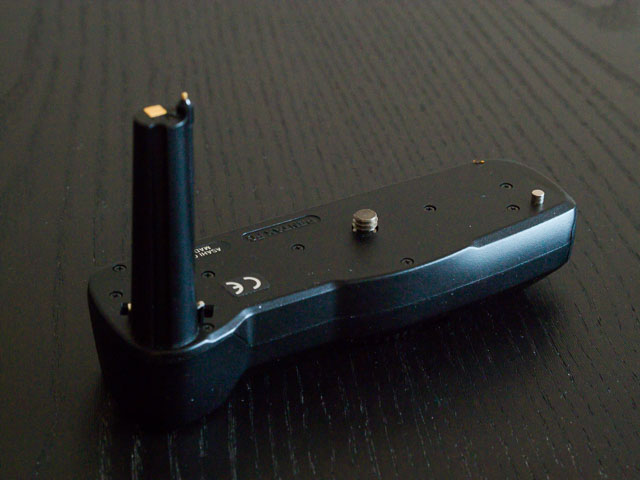
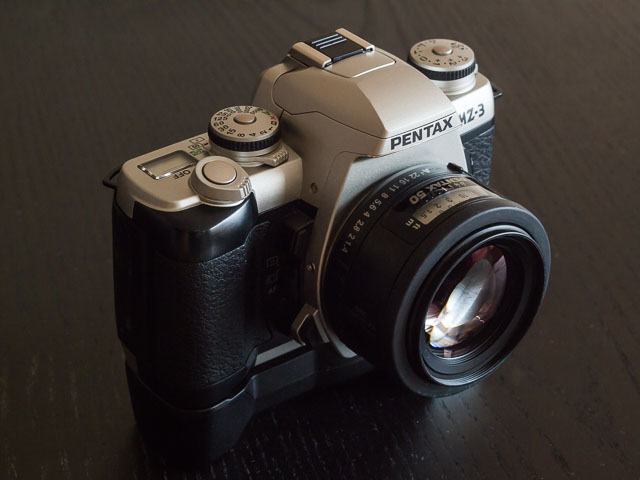
Pentax FG data back
My MZ-3 came fitted with this horrible data back. It allows you to print the date and time in horrible orange numbers on all your photos. Unless you’re a scientist or insurance loss adjuster I can’t imaging why on earth you would want to! The data back also adds unnecessary bulk to the svelte little MZ-3.
Fortunately all MZ series camera take exactly the same back and I just happened to have a non-functioning Pentax MZ-50 lying around with a plain back (it came with the 28-70mm lens below), and it was a simple job to swap the backs over.

SMC Pentax-FA 28-80mm f/3.5-5.6
This is the lens that originally came with my MZ-3. It’s a very nice match aesthetically, but it’s really not a great lens so I wanted to do better!


SMC Pentax-FA 28-70mm f/4
bought this lens to go with an MZ-5n I bought from Rocky Cameras. That camera had to go back (warning: treat this company with extreme caution!!) but it now makes a very nice match for the MZ-3. It’s smaller than the 28-80mm and it balances perfectly.

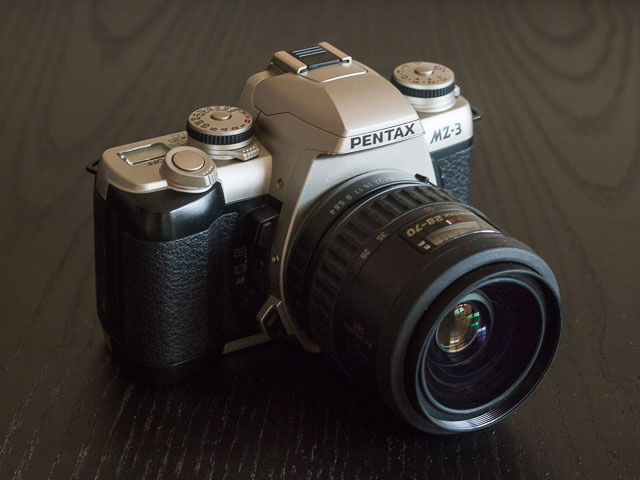
SMC Pentax-FA 50mm f/1.4
I bought this lens to go with my Pentax DSLR some time ago. But as an FA lens is it contemporary with the MZ-3, so I thought I should put it on this page. (But it has now been sold.)


Links
- Pentax MZ-5n manual on butkus.org (Note that the only difference between the MZ-5n and the MZ-3 is the top shutter speed)
- Pentax MZ-3 specification on kmp.bdimitrov.de
